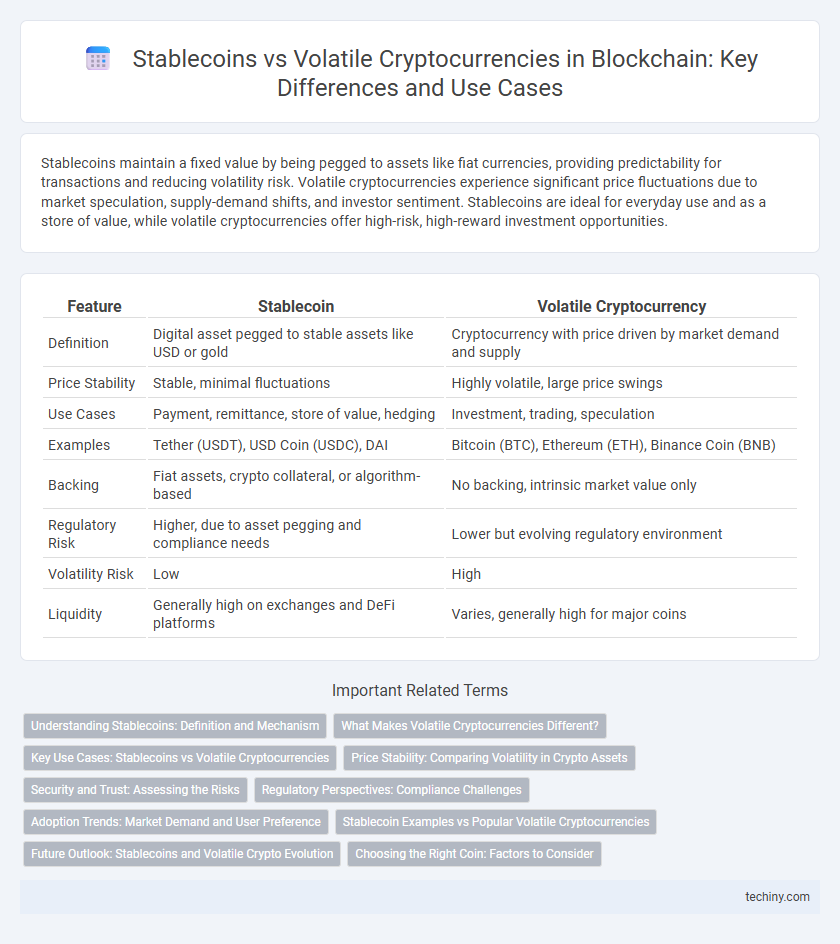Stablecoins maintain a fixed value by being pegged to assets like fiat currencies, providing predictability for transactions and reducing volatility risk. Volatile cryptocurrencies experience significant price fluctuations due to market speculation, supply-demand shifts, and investor sentiment. Stablecoins are ideal for everyday use and as a store of value, while volatile cryptocurrencies offer high-risk, high-reward investment opportunities.
Table of Comparison
| Feature | Stablecoin | Volatile Cryptocurrency |
|---|---|---|
| Definition | Digital asset pegged to stable assets like USD or gold | Cryptocurrency with price driven by market demand and supply |
| Price Stability | Stable, minimal fluctuations | Highly volatile, large price swings |
| Use Cases | Payment, remittance, store of value, hedging | Investment, trading, speculation |
| Examples | Tether (USDT), USD Coin (USDC), DAI | Bitcoin (BTC), Ethereum (ETH), Binance Coin (BNB) |
| Backing | Fiat assets, crypto collateral, or algorithm-based | No backing, intrinsic market value only |
| Regulatory Risk | Higher, due to asset pegging and compliance needs | Lower but evolving regulatory environment |
| Volatility Risk | Low | High |
| Liquidity | Generally high on exchanges and DeFi platforms | Varies, generally high for major coins |
Understanding Stablecoins: Definition and Mechanism
Stablecoins are digital assets designed to maintain a stable value by pegging their price to a reserve asset such as the US dollar, gold, or a basket of assets, minimizing volatility common in cryptocurrencies like Bitcoin and Ethereum. They employ mechanisms like fiat-collateralization, crypto-collateralization, or algorithmic supply adjustments to ensure price stability and facilitate seamless transactions. Understanding these mechanisms is crucial for evaluating how stablecoins provide liquidity and act as reliable mediums of exchange within the blockchain ecosystem.
What Makes Volatile Cryptocurrencies Different?
Volatile cryptocurrencies experience rapid price fluctuations due to factors such as market speculation, limited liquidity, and regulatory uncertainty, which creates high risk and potential for substantial gains or losses. Unlike stablecoins pegged to fiat currencies or assets, volatile cryptocurrencies rely purely on supply-demand dynamics within decentralized networks like Bitcoin or Ethereum. Their value is heavily influenced by investor sentiment, technological developments, and macroeconomic trends, making them less predictable and more susceptible to market manipulation.
Key Use Cases: Stablecoins vs Volatile Cryptocurrencies
Stablecoins offer predictable value, making them ideal for everyday transactions, remittances, and as a hedge against market volatility. Volatile cryptocurrencies, such as Bitcoin and Ethereum, are primarily used for speculative investment, decentralized finance (DeFi) applications, and as a store of value with high growth potential. Businesses leverage stablecoins for cross-border payments and payroll, while investors use volatile cryptocurrencies to capitalize on price fluctuations.
Price Stability: Comparing Volatility in Crypto Assets
Stablecoins maintain price stability by pegging their value to a reserve asset like the US dollar, reducing volatility and providing predictable purchasing power. In contrast, volatile cryptocurrencies such as Bitcoin and Ethereum experience significant price fluctuations driven by market demand, speculation, and regulatory news. This fundamental difference makes stablecoins preferred for transactions and savings, while volatile cryptocurrencies are favored for investment and trading opportunities.
Security and Trust: Assessing the Risks
Stablecoins offer enhanced security and trust by maintaining price stability through collateral backing or algorithmic control, reducing the risk of sudden value loss. Volatile cryptocurrencies expose investors to high price fluctuations, increasing the potential for financial loss and market manipulation. Security concerns for both include smart contract vulnerabilities and regulatory scrutiny, but stablecoins generally provide a more predictable risk profile for users and institutions.
Regulatory Perspectives: Compliance Challenges
Stablecoins face stringent regulatory scrutiny due to their pegged value and potential impact on financial stability, requiring issuers to maintain transparency and sufficient collateral reserves to ensure compliance with anti-money laundering (AML) and know-your-customer (KYC) regulations. In contrast, volatile cryptocurrencies pose challenges in regulatory classification and oversight because of their price fluctuations and decentralized nature, complicating the enforcement of investor protection laws and taxation rules. Regulatory agencies emphasize the need for robust frameworks to address systemic risks posed by both stablecoins and volatile cryptocurrencies while fostering innovation in the blockchain ecosystem.
Adoption Trends: Market Demand and User Preference
Stablecoins exhibit increasing adoption due to their price stability, making them preferred for everyday transactions and remittances. Volatile cryptocurrencies maintain strong demand among investors seeking high returns and speculative trading opportunities. Market preference trends indicate a growing bifurcation between stablecoins for practical use and volatile cryptocurrencies for investment purposes.
Stablecoin Examples vs Popular Volatile Cryptocurrencies
Stablecoins such as Tether (USDT), USD Coin (USDC), and Dai (DAI) maintain value stability by being pegged to fiat currencies or collateralized assets, making them ideal for everyday transactions and hedging against market volatility. In contrast, popular volatile cryptocurrencies like Bitcoin (BTC) and Ethereum (ETH) experience significant price fluctuations driven by market demand, investor sentiment, and technological developments. Choosing between stablecoins and volatile cryptocurrencies depends on whether users prioritize transactional stability or high-risk, high-reward investment opportunities.
Future Outlook: Stablecoins and Volatile Crypto Evolution
Stablecoins are expected to play a crucial role in mainstream adoption by providing price stability and reducing transaction risks, supported by increasing regulatory frameworks and institutional interest. Volatile cryptocurrencies will continue driving innovation and speculative investment, with advancements in DeFi and cross-chain interoperability shaping their evolution. The coexistence of stablecoins and volatile assets will foster a diverse ecosystem, balancing stability with growth potential in the blockchain economy.
Choosing the Right Coin: Factors to Consider
Choosing the right coin involves assessing stability, use case, and risk tolerance, with stablecoins offering predictable value linked to assets like the US dollar, making them ideal for transactions and hedging against volatility. Volatile cryptocurrencies such as Bitcoin and Ethereum present higher growth potential but come with significant price fluctuations driven by market demand and investor sentiment. Evaluating factors like liquidity, regulatory environment, and intended application ensures alignment with individual financial goals and risk management strategies.
Stablecoin vs Volatile cryptocurrency Infographic

 techiny.com
techiny.com